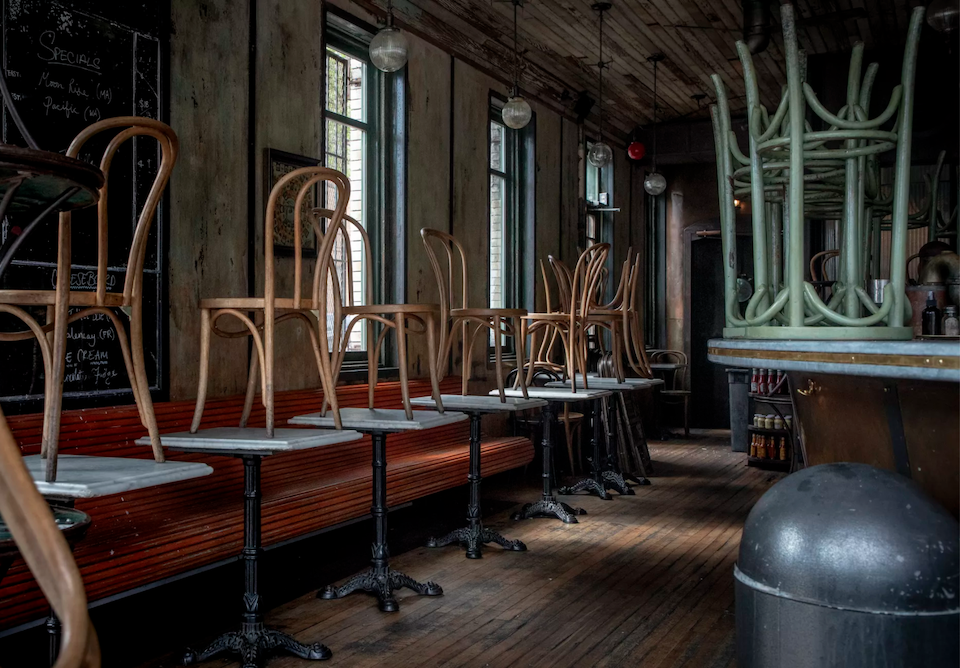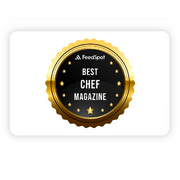There Will Be No Grand Reopening for Restaurants
Masked waiters, half-empty dining rooms, and mobile ordering may all be part of the new reality when restaurants open their doors again
EATER – 17 April, 2020
InIn a press conference this week to discuss the gradual reopening of public spaces in California, Gov. Gavin Newsom, a former San Francisco restaurateur, referred to himself as “someone, like yourself, that looks forward to going back out and having dinner.” But when California’s restaurants do reopen — minus an estimated 30 percent that could permanently close during the COVID-19 crisis, according to the state’s restaurant lobby — Newsom’s regular table might not look like it used to.
InIn a press conference this week to discuss the gradual reopening of public spaces in California, Gov. Gavin Newsom, a former San Francisco restaurateur, referred to himself as “someone, like yourself, that looks forward to going back out and having dinner.” But when California’s restaurants do reopen — minus an estimated 30 percent that could permanently close during the COVID-19 crisis, according to the state’s restaurant lobby — Newsom’s regular table might not look like it used to.
“You may be having dinner with a waiter wearing gloves,” suggested the governor, drawing on previous remarks made by California public health director Dr. Sonia Angell. “Maybe a face mask, a dinner where the menu is disposable, where the tables, half of the tables in that restaurant no longer appear, where your temperature is checked before you walk into the establishment.”
The message to restaurant operators and patrons: Don’t expect a grand reopening. A rolling soft opening might be more like it.
In order for the public to return to spaces like bars and restaurants before a vaccine for the novel coronavirus is available, which could be more than a year, public health experts say there are some major prerequisites for safety. Those include expanded capacity for COVID-19 testing, perhaps new antibody tests to show who has previously been infected, and a system of contact tracing (a process of identifying who may have been exposed to the virus) by either manual or digital methods.
Last night, the White House released “Guidelines for Opening America Again,” which included its own proposed criteria for states to reopen: a two-week downward trajectory of positive tests and flu-like and COVID-19-like symptoms reported, hospital capacity to treat all patients without crisis care, and “robust testing” for health care workers including “emerging antibody tests.” But according to the CDC, its own evaluation of antibody tests won’t be completed until “late April.”
Politicians like New York Gov. Andrew Cuomo have pointed out that requirements, particularly around testing, haven’t been met. “The more testing, the more open the economy. But there’s not enough national capacity to do this,” Cuomo, who plans to coordinate New York’s reopening with like-minded governors from neighboring states, said in a recent meeting. “We can’t do it yet.” A mix of private and public testing in the U.S. is now evaluating just about 100,000 cases a day; experts like Nobel laureate economist Paul Romer suggest 22 million tests per day are necessary.
That all leaves restaurant and bar owners with the difficult and maddening task of planning for an uncertain future, gaming out many possible reopening timelines and new business models. “The restaurant industry seems particularly vulnerable to a long crisis,” write the authors of a working paper from the National Bureau of Economic Research. Restaurateurs told researchers they have a 72 percent chance of survival if the crisis lasts one month — but if it persists for four months, they give themselves just a 30 percent chance of survival. If it lasts for six months, they put their chances at 15 percent. Should restaurants apply for more loans on the assumption that they won’t reopen until later? Or should they seek less debt hoping to open sooner?
If full reopening is six months away rather than two, for example, choosing to stay open for takeout and delivery — the only path available to most restaurants in the U.S. — might not be worth the trouble. “I wanted to protect as many employees’ job status as I could, and I wanted to show spirit and feed the community,” Andy Ricker, chef and owner of Portland’s Pok Pok restaurant group, told Eater this month when he decided to close takeout and delivery operations. “I don’t think anyone who is staying open is really thinking they’ll make money — most of them are scared that if they close, they’ll lose everything.”
Lingering questions about the virus itself complicate long-term planning, too. “There are a lot of unanswered questions about COVID-19,” says Stefan Baral, an associate professor of infectious disease epidemiology at the Johns Hopkins Bloomberg School of Public Health. “One is how infectious is someone in that asymptomatic or presymptomatic stage? And it’s very much an open question.”
When more is clear and restaurants do return, one guideline that experts are likely to agree upon is limiting restaurant capacities to allow for better physical distancing. “The restaurant industry and bar industry are going to have to work closely with public health officials regarding spacing, which is now guided mostly by fire safety rules rather than public safety measures,” Baral says. The World Health Organization echoes the call for these distancing measures at restaurants in guidance geared toward the hospitality sector.
This possible new normal for the U.S. is already underway in areas that experienced COVID-19 before North America, such as China. There, restaurateur Jean-Georges Vongerichten reopened his businesses in Shanghai and Guangzhou at the end of March. “When you walk into the restaurant, it’s all government rules — there are a lot of restrictions,” says Vongerichten. “Taking the temperature from all the chefs, taking temperature from the customers as well; no table bigger than four, spaced six to eight feet between tables. Nobody touches money, so people go to an app for the restaurant on their phone, the waiter just brings wine, water, and food.
“It’s very limited, restricted, but it seems to be working,” Vongerichten says. Business in China is back about 40 or 50 percent, he estimates. But the strangest change is the sound: Nobody talks to anybody, and it’s deathly quiet in the dining room.
“I hope we don’t have to do all that here [in the U.S.],” says Vongerichten. “I’d prefer not to open like that it’s a very different model now.”
Diminished capacity in restaurants would also fundamentally change their revenue model, says Anjan Mitra, owner of the longstanding San Francisco restaurant DOSA. “The whole idea with restaurants is to squeeze in as many people as possible. You’re paying rent for the month, and you’re open for like five hours a night,” he says. “Now if you say we have to reduce our density, our capacity, restaurants are going to focus a lot more on online delivery and pickup.” During San Francisco’s shelter-in-place order, DOSA has continued off-premises sales, like delivery and prepared food sold through Whole Foods.
“Restaurants need to plan for what 50 percent capacity dining-in looks like,” the restaurateur Dave Chang tweeted. “We are way past due for an updated national protocol for food safety in a COVID-19 world. Restaurant workers need to know what PPE to use. These are things we can plan for now.”
Wolfgang Puck is another restaurant owner starting to think about the challenges of this new reality. “If we don’t have as many tables, we won’t need as many employees,” he points out. And back-of-the-house social distancing and safety for employees needs to be considered, too — employers in states like New York are now required to provide cloth face masks for employees.
Restaurant workers, many of whom don’t have health care in the first place and might rely on income for medical costs, are also statistically at higher risk for COVID-19. According to the Bureau of Labor Statistics, black and brown people made up 40 percent of restaurant workers last year, and in Chicago, for example, where black residents make up 29 percent of the city’s population, 72 percent of Chicagoans who have died from the disease were black.
“COVID is highlighting the inequalities we already see in our society, both socially and [in] how it relates to health,” says Dustin Duncan, a professor of epidemiology at Columbia’s Mailman School of Public Health.
As New York Rep. Alexandria Ocasio-Cortez put it in an ABC appearance this week, “ultimately, it’s inequity that’s the preexisting condition.” That inequality affects us all, she argued. “When the person who is preparing your food can’t see a doctor, that puts you at risk — that puts all of us at risk.”
Another contingency that restaurants might need to plan for is rolling quarantines and shutdowns in response to subsequent outbreaks. In Hong Kong, the strategy is called “suppress and lift”: Rather than impose a complete shutdown, the city has fought COVID-19 cases with rigorous testing — thus far, it has conducted 13,800 tests per million people — and quarantine policies for the infected, while allowing businesses like restaurants to stay open as usual. When cases spiked from 149 in March to 1,005 in April, Hong Kong rolled out its “suppress” strategy: Bars were closed for a few weeks and new restrictions were imposed on restaurants, such as capping them at 50 percent capacity and requiring they check customers’ temperatures at the door. As a result, the uptick in cases already appears to be stifled, writes Science magazine. On April 23, bars are scheduled to reopen.
Seen less elegantly, that strategy could also be called “playing whack-a-mole” with the virus, Ed Yong writes in the Atlantic. It’s a game we, as a society, might need to keep playing until a vaccine is developed, and experts at the Center for American Progress, a liberal-leaning policy group, are worried about the lack of clear rules. “Without a coherent, evidence-based plan in place — a path forward, clear benchmarks, and an end in sight — the public and government officials may grow weary of physical distancing prematurely,” they write. “The result would be repeated waves of exponential transmission followed by lockdowns, wreaking havoc on the economy and peoples’ lives.” If restaurants reopen, then reclose, will they be entitled to a second wave of disaster and stimulus loans, for example? “It will be far more devastating to our economy — and to public health — to experience waves and waves of virus response rather than properly return to normal when it is truly safe,” the Center for American Progress argues.
This week, as President Donald Trump publicly flirted with the idea of reopening the U.S. economy quickly, the World Health Organization offered criteria for countries thinking about relaxing their mitigation measures, including that of adequate health system capacity. “Control measures must be lifted slowly, and with control,” said WHO director general Tedros Adhanom Ghebreyesus. “In other words, the way down is much slower than the way up.”
The way down could also look like a rickety staircase, with secondary outbreaks causing plateaus or even upticks. During that time and beyond it, mobile order-ahead and pickup, as at Starbucks and other chains, could become a ubiquitous tool, some experts predict. Social media, meanwhile, could offer some help to restaurants and bars, many of which are already beginning to lean heavily on their social media channels for a sense of connection with customers and updates on takeout and delivery offerings. As they potentially reopen (and reclose) in spurts, essential updates on Instagram about who’s open and in what capacity could be crucial for sales.
But what restaurant can possibly incorporate the possibility of rolling lockdowns into its business plan? “I don’t know how much planning you can really do for it,” says Ian Boden, chef-owner of the Shack in Staunton, Virginia. “The goal is to stay as lean as you possibly can.”
“Lean” is a good way to describe the Shack, a tiny prix fixe restaurant that was forced to close just weeks after receiving a three-star rave from the Washington Post. When the Shack does eventually reopen, Boden expects that tastes will have changed. Because he anticipates fewer tourists seeking destination dining, he’ll have to scrap the prix fixe he’s spent years honing in favor of less expensive, more casual food. “It’s a little heartbreaking, but I have bills to pay, I have people that rely on me and depend on me, so I have to think strategically,” Boden says.
Chef Dan Barber, famous for his tasting menus at Blue Hill and Blue Hill Stone Barns, seems to agree. “We will not be returning to normal even when we’re allowed to,” Barber told Time. “The idea that people are going to be spending money in restaurants is preposterous. We’re headed for an enormous recession.”
Maybe so, but Stefan Baral of Johns Hopkins does expect people will want to return to public life, including restaurant dining rooms. It will even do us some good. “Part of the idea of returning to normalcy is that businesses are able to function — but [it’s] also that people are able to socialize and enjoy themselves as a core part of wellbeing,” Baral says.
When more of us do return to socializing, other epidemiologists, like Columbia’s Dustin Duncan, hope they’ll see public health held in higher regard than before. In restaurants, Duncan predicts “increased attention to prevention and health and well-being” of both patrons and workers.
“I think there will be a new normal, and we’ll also see and understand that we aren’t individual actors, but that we’re all connected,” he says. “What happens in one place affects another, what happens in one person’s body impacts another person’s.”
From Eater













